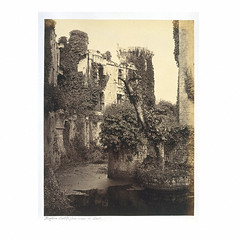By Stuart Frost
The surviving architecture of medieval Britain perfectly encapsulates the spirit of the age. The ruins of castles and abbeys have provided inspiration for many generations of painters, poets and photographers. The photograph of Raglan castle reproduced below has been chosen for inclusion in a display I’m pulling together that will be installed late in 2009. We’ve recently confirmed a selection of twenty-five prints from the V&A’s vast collection of photographs, all of which feature nineteenth century views of medieval and Renaissance buildings. Click on the image of Raglan for a more detailed view.

Raglan Castle is located in south-east Wales, not far from the town of Monmouth. I’ve been researching the background to the castle so that I can write an object label for it and a longer database entry. I last visited Raglan on 6 September 1992. The reason I can be so precise is because the admission ticket dropped out of my old copy of the castle guidebook when I opened it. Like many people who work in museums I’m not very good at throwing things away!
Raglan was once an extremely impressive residence and fortress. Enough of the castle survives to give a vivid impression of the scale of the building and the comfortable accommodation it provided. Its architecture and furnishings reflected the wealth and status of its owners who included the Earls of Pembroke, the Earl of Huntingdon and the Earls of Worcester. Most of the surviving structure dates from the fifteenth and sixteenth centuries. How did such a magnificent and costly castle become reduced to the impressive and romantic ruin that we can see in this photograph?
The castle was held by Royalist forces during the English Civil War and was surrendered to Parliamentarians on 19th August 1646 after a siege which involved the use of mortars and cannon. Shortly afterwards the castle was deliberately slighted to ensure that it couldn’t be used easily as a fortress again. Further depredation occurred throughout the late seventeenth and eighteenth centuries as the castle buildings were plundered for building materials. This is story that rings true for many castles in England and Wales. It was only in 1938 that the castle was placed under the protection of the Commissioners of His Majesties Works and a programme of conservation was carried out.
Today many of us enjoy visiting castles like Raglan but this sort of leisure pursuit isn’t as recent as you might think. A guide to Raglan was published in 1792 and was in its eleventh edition by 1829. Visiting castles is one of my greatest pleasure but I’d love to have been able to explore castle ruins as there were before they were tidied up in the twentieth century. The vegetation that you can see in this image taken in 1860 portrays Raglan as a romantic ruin, a victim of the relentless progress of time. Photographs like this became popular in the decades following the invention of photography and two other prints of Raglan by the same photographer were published in 1862 in a volume, Ruined Abbeys and Castles of Great Britain, that catered for this demand.
Early architectural photographs are a valuable record of the appearance of many great medieval buildings before the impact of organisations like English Heritage, CADW and the National Trust in preserving and interpreting them. These organisations, and others like them across Europe, play a vital and role in preserving the architectural heritage of medieval and Renaissance Europe. However part of the appeal of nineteenth century photographs like this one is that they evoke a sense of romance, discovery and mystery that I think is difficult to recapture when visiting a castle today. Personally I find that the more heavily interpreted a site is, and the more carefully manicured the surroundings, the less space there is for my imagination to wander.
For more information about Raglan Castle visit the CADW (Welsh Historic Monuments) website.
Anyone who has a passion for castles will find the Castle Studies Group website of interest.
Comments